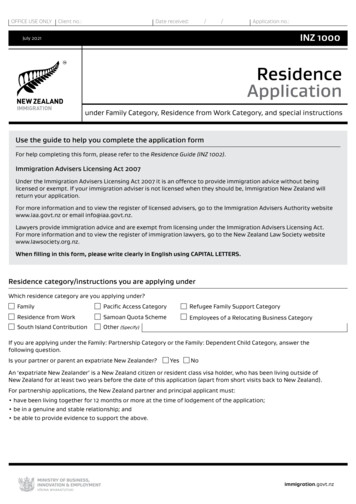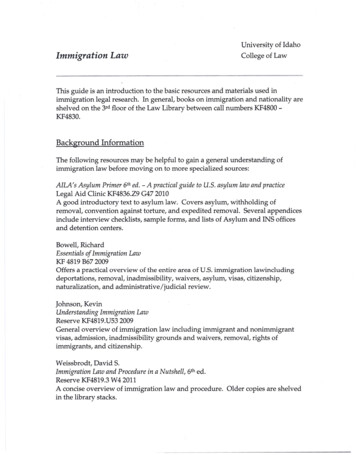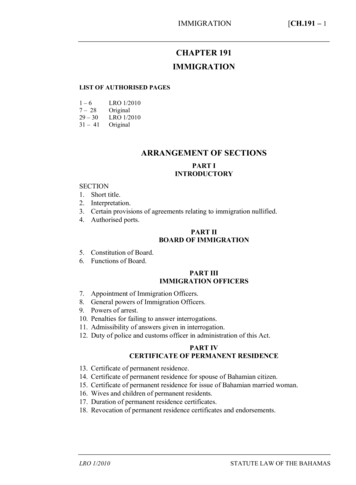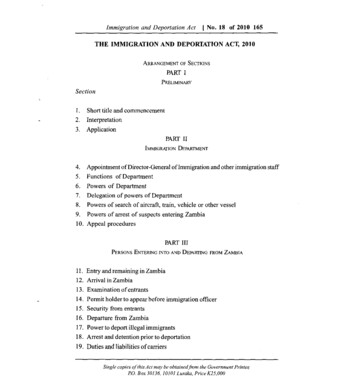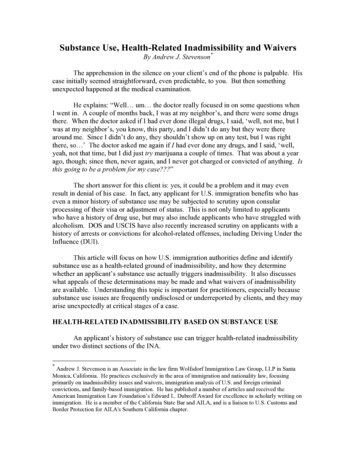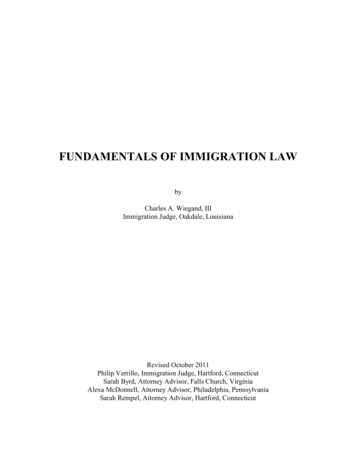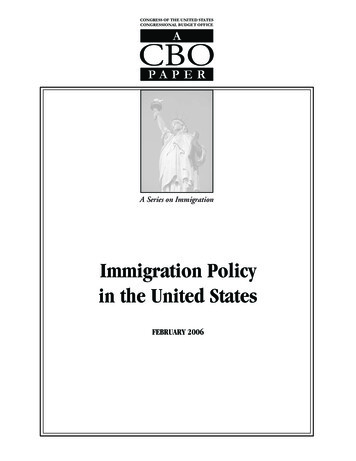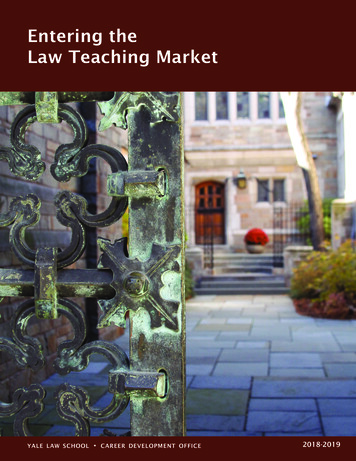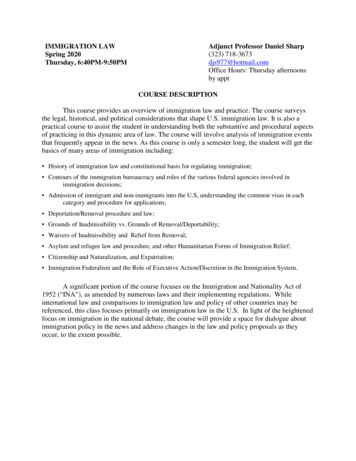
Transcription
IMMIGRATION LAWSpring 2020Thursday, 6:40PM-9:50PMAdjunct Professor Daniel Sharp(323) 718-3673djs977@hotmail.comOffice Hours: Thursday afternoonsby apptCOURSE DESCRIPTIONThis course provides an overview of immigration law and practice. The course surveysthe legal, historical, and political considerations that shape U.S. immigration law. It is also apractical course to assist the student in understanding both the substantive and procedural aspectsof practicing in this dynamic area of law. The course will involve analysis of immigration eventsthat frequently appear in the news. As this course is only a semester long, the student will get thebasics of many areas of immigration including: History of immigration law and constitutional basis for regulating immigration; Contours of the immigration bureaucracy and roles of the various federal agencies involved inimmigration decisions; Admission of immigrant and non-immigrants into the U.S, understanding the common visas in eachcategory and procedure for applications; Deportation/Removal procedure and law; Grounds of Inadmissibility vs. Grounds of Removal/Deportability; Waivers of Inadmissibility and Relief from Removal; Asylum and refugee law and procedure, and other Humanitarian Forms of Immigration Relief; Citizenship and Naturalization, and Expatriation; Immigration Federalism and the Role of Executive Action/Discretion in the Immigration System.A significant portion of the course focuses on the Immigration and Nationality Act of1952 (“INA”), as amended by numerous laws and their implementing regulations. Whileinternational law and comparisons to immigration law and policy of other countries may bereferenced, this class focuses primarily on immigration law in the U.S. In light of the heightenedfocus on immigration in the national debate, the course will provide a space for dialogue aboutimmigration policy in the news and address changes in the law and policy proposals as theyoccur, to the extent possible.
Immigration LawProfessor SharpSpring 2020Page 2 – syllabusLEARNING GOALS 1After completion of this course, you should be able to competently:1. Analyze the federal immigration statute, regulations, case law and other legal authoritiesrelevant to immigration law.2. Apply the relevant statutes, standards, principles, and rules when presented inhypothetical and unfamiliar fact patterns.3. Understand, and think critically about, the principles and policies behind our current andpast system of immigration law.4. Communicate, both orally and in writing, appropriate legal and factual arguments insupport of each side of controversies involving commonly encountered issues inimmigration law.5. Communicate, both orally and in writing, with immigrant clients (including those withlimited formal education) regarding prospective eligibility for immigration relief andmatters related to effective case preparation.1These learning goals arise out of Western State College of Law at Westcliff University’s Programmatic Learning Outcomes, which arereproduced here. Western State College of Law’s curriculum is designed so that every student achieves a level of competency priorto graduation in each of the eight Programmatic Learning Outcomes listed below: (1) Doctrinal Knowledge (Students will demonstrateknowledge of substantive and procedural law in the core curriculum subjects, including Contracts, Criminal Law, Criminal Procedure, Torts,Real Property, Business Association, Evidence, Civil Procedures, Constitutional Law, Estates, Community Property, Remedies, andProfessional Responsibility); (2) Practice Skills (Students will demonstrate the development of other law practice skills. Each student’s chosenoutcomes within this category will be varied based on the student’s particular interests, coursework and work experiences. They may include,but are not limited to, the following topics: oral presentation and advocacy; interviewing; counseling; client service and business development;negotiations, mediation, arbitration, or other alternate dispute resolution methods; advanced legal research and writing (excluding purelyacademic papers and the first four units earned in introductory first-year legal research and writing class); applied legal writing such as draftingcontracts, pleadings, other legal instruments; law practice management or the use of technology in law practice; cultural competency;collaboration or project management; financial analysis, such as accounting, budgeting project management, and valuation; cost benefitanalysis in administrative agencies; use of technology, data analyses, or predictive coding; business strategy and behavior; pre-trialpreparation, fact investigation, such as discovery, e-discovery, motion practice, assessing evidence, or utilizing experts; trial practice;professional civility and applied ethics; a law clinic that includes a classroom component; or a legal externship that includes a classroomcomponent. (3) Legal Analysis (Students will demonstrate the ability to identify the factual and legal issues implicated by a fact pattern and toappropriately use cases (including identifying the salient features of an appropriate precedent case, identifying legally significant similarities ordifferences between the precedent case and a fact pattern and explaining why those are legally significant) and rules (including the ability toconnect legally significant facts in a fact pattern to the rule) to predict how a court would decide the issue. Students will also demonstrate theability to identify and evaluate the public policies of a precedent case or rule, and be able to evaluate how public policy can impact theapplication of a rule to the legal issue.) (4) Legal Research (Students will demonstrate the ability to locate relevant legal authority using avariety of book and electronic resources, and to properly cite to such legal authority. (5) Communication (Students will demonstrate the abilityto communicate both orally and in writing in a manner appropriate to a particular task to effectively convey the author or speaker’s ideas. Thisincludes audience sensitivity in written and oral communication (the ability to adopt a tone, style and level of detail appropriate to the needs,knowledge and expertise of the audience); and written communication basic proficiency (the ability to use the conventions of grammar,spelling, punctuation, diction and usage appropriate to the task and sufficient to convey effectively the author’s ideas). (6) Advocacy of LegalArgument (Students will demonstrate the ability, in both oral and written formats, to evaluate the legal, economic and social strengths andweaknesses of a case and use case and statutory authority as well as public policy to persuade others. Making policy-based argumentsincludes the ability to identify and evaluate the public policies of a precedent case or rule and their implications, and be able to assert suchappropriate arguments to support a particular application or distinction of a precedent case to a legal controversy or a particular resolution ofthe application of a rule to the legal controversy.) (7) Client Sensitivity and Cultural Competency (Students will demonstrate an awareness ofclients’ needs and goals, including a sensitivity to clients’ background and circumstances (including, but not limited to, socio-economic,gender, race, ethnicity, educational, disability and/or religious background(s)), the ability to make decisions that reflect an appropriate focus onthose needs and goals, and awareness that cultural issues may affect the relevance of facts and application of the law.) (8) Legal Ethics(Students will demonstrate the ability to identify ethical issues in law practice contexts and make appropriate decisions to resolve such issues.2
Immigration LawProfessor SharpSpring 2020Page 3 – syllabusCOURSE MATERIALSThe following course materials are required:1) Stephen H. Legomsky & David B. Thronson, Immigration and Refugee Law and Policy(7th ed. 2018).The seventh edition of the Legomsky textbook was used during the Spring 2019Immigration Law course. Do not use the sixth edition, as the seventh edition madesubstantial updates.2) Immigration & Nationality Act (INA) Regulations. You have two options:a. Aleinikoff, Martin, Motomura, Fullerton, and Stumpf, Immigration andNationality Laws of the United States: Selected Statutes, Regulations, Forms,2018. (2016 version also acceptable.)b. American Immigration Lawyers Association (AILA), Immigration & NationalityAct Immigration Regulations (CFR). 2019, 2018 or 2016 Editions areacceptable.We will not begin to use INA regulations until week 3. Also, either option will sufficefor the course. As a practitioner, I have used both the Aleinikoff and AILA texts and prefer theAILA books for daily use. The separate AILA INA and CFR books are considerably moreexpensive than the Alienikoff text, which includes both INA and certain regulations in the samebook. The AILA regulations publication includes the entire Title 8 C.F.R., as well as a secondvolume comprised of Titles 6 and various others. Unfortunately, AILA only sells the regulationsas a two-volume combo. We will reference Title 8, but we will rarely, if ever, reference the otherregulation titles during the course. A considerable student discount is available for the AILAINA & regulations books. So if you plan to purchase the AILA publication(s), be sure to obtainthe student code purchase form from me or Sarah Eggleston. But I assure you that the Aleinikofftext will suffice for the course, including a 2016 copy.The assigned readings are often significant and will keep you sufficiently busy. Irecommend that you read the assigned material, including statutory references, multiple timesbefore turning elsewhere. If you want to read supplementary materials, the most thoroughreference work for immigration practice is the multi-volume treatise by Charles Gordon, StanleyMailman, & Stephen Yale-Loehr, Immigration Law and Procedure (Matthew Bender), which isavailable in the Immigration Clinic library. (This treatise appears on several “essentialmaterials” lists). By far the most common practice-based book is the Immigration LawSourcebook by Ira Kurzban, which is also in the Immigration Clinic library. For currentimmigration information, an online resource is Bender’s Immigration Bulletin (available atwww.bibdaily.com).3
Immigration LawProfessor SharpSpring 2020Page 4 – syllabusGRADING AND LIST OF ASSIGNMENTSImmigration Law is an elective course. If you are a candidate for the Immigration LawCertificate, then Immigration Law is a required course in order to obtain the Certificate.Immigration Law also satisfies the elective component of the Criminal Law Practice Certificate.Please note that Immigration Law does not satisfy the Upper Level Writing Requirement.The course will be graded according to the following evaluation criteria: Class Preparation, Participation and Teamwork (25% of grade): 2 Like the rest ofthe faculty, I value in-class contributions and professionalism. Assigned reading willvary from week to week and may be substantial on occasion. Nonetheless, I expectyou to come to class prepared. I aim for all classes to include substantial dialogueabout the assigned material and expect all students to participate in class discussionevery week. We will also conduct several in-class exercises, including simulatedclient interviews, which will be factored into the class participation grading.Immigration News Briefing (5% of grade): Each student will receive a date topresent a current immigration issue that has been discussed in the news. Beginning inweek 2, class will begin with an “Immigration News Briefing”. The assigned studentwill give a summary of the news item, relating the information to relevant courseworkor policy issues that have been discussed. The student will lead a short classdiscussion following the news briefing. Students are required to submit an electroniccopy to their classmates in anticipation of their presentation on their assigned day.More information will be provided during Class 1.Naturalization Workshop: (10% of grade): I greatly value volunteerism. Studentswill apply client interviewing and legal analysis skills from the class by participatingin a naturalization workshop. Date, time and location TBD.Topic Quizzes (10% of grade): I will administer periodic quizzes during the semesterthat may include multiple choice, short answer, and brief essay questions.Final Examination (50% of grade): The final examination will likely consist of acombination of multiple choice, short answer, and essays. It will likely be a threehour exam in which you are able to bring the textbook, INA and regulations.2While I take attendance, it is always your own responsibility to keep track of your absences. Absences, if at alloccurring, should be reserved for exceptional circumstances. If you have missed or will miss class, please review aclassmate’s notes and the class Powerpoint slides and see me as soon as possible after the absence if you still havequestions about the material. In accordance with the WSCL academic policy and as described in the StudentHandbook, a student who misses more than four 1.5-hour class sessions will be withdrawn from class.4
Immigration LawProfessor SharpSpring 2020Page 5 – syllabusAPPOINTMENTS AND OFFICE HOURSI will hold office by appointment on Thursday afternoons. You may schedule anappointment by contacting me directly at djs977@hotmail.com. I am happy to discuss thecourse, assignments, policy issues, and career opportunities.DISABILITY SERVICES STATEMENTWestern State College of Law provides accommodations to qualified students withdisabilities. The Disabilities Services Office assists qualified students with disabilities inacquiring reasonable and appropriate accommodations and in supporting equal access toservices, programs, and activities at Western State College of Law.To seek reasonable accommodations, a student must contact Senior Assistant DeanDonna Espinoza, Student Services Director and Disabilities Services Coordinator, whose officeis in the Students Services Suite 119. Dean Espinoza’s phone number and email address are:(714) 459-1117; despinoza@wsulaw.edu. When seeking accommodations, a student shouldnotify Dean Espinoza of her or his specific limitations and, if known, her or his specificrequested accommodations. Students who seek accommodations will be asked to supply medicaldocumentation of the need for accommodation. Classroom accommodations are not retroactive,but are effective only upon the student sharing approved accommodations with the instructor orprofessor. Therefore, students are encouraged to request accommodations as early as feasiblewith Dean Espinoza to allow for time to gather necessary documentation. If you have a concernor complaint in this regard, please notify Dean Espinoza; or please notify Dean Allen Easley ataeasley@wsulaw.edu or (714) 459-1168. Complaints will be handled in accordance with theCollege of Law’s “Policy against Discrimination and Harassment.”SYLLABUSI have provided the topics that I expect to cover for the semester, as well as readings to becovered throughout the semester. However, I will update the syllabus as we progress andassigned readings may change. Check in with me before getting more than a week ahead on thereadings. It is difficult to anticipate how long it will take to discuss each topic and occasionallywe may spend more time on a topic than initially anticipated. Please expect occasionaladjustments to the syllabus throughout the semester.Immigration law is governed primarily by one large, sprawling statute: the Immigrationand Nationality Act, or INA. Familiarity with the INA is critical to success in this course, and inthe practice of immigration law generally. Where I have assigned a section of the INA thatcontains subsections, you should read all of the subsections (e.g., if INA § 212(a) is assigned,then please read all of the subsections of 212(a)). The INA is a complicated statute, and it isdifficult to read in isolation. You should therefore read the assigned sections of the INA whenthey are referenced in the casebook, even if I have not specifically assigned them.5
Immigration LawProfessor SharpSpring 2020Page 6 – syllabusThe casebook contains a number of hypothetical fact patterns (“problems”), some ofwhich will be discussed in class. I have designated specific problems for you to be prepared todiscuss. Many of the problems will require you to engage in a detailed analysis of the statute andapply the principle or rule from the reading to a new, hypothetical fact pattern. It is very difficultto be prepared in class, or to have a sophisticated discussion of the problem, if you are workingfrom memory or if your preparation was vague. Therefore, for each problem, I recommend thatyou bring to class a set of typewritten answers, along with a record of the sources you consultedto answer the problem.You should expect to spend at least 6 hours each week outside of class on readings,exercises, note-taking, review, assignments and other class preparation. This is a rough estimate.You will likely find that some weeks you need to spend more (and possibly less) than theestimated amount of time. I appreciate that students have many demands on their time, includingother classes, employment, and family. Given the breadth of the subject matter, however,significant reading time is necessary. The class involves substantive law from a practitioner’sperspective, as well as analysis of various constitutional and policy issues. Those who plan topractice immigration law may find this “big picture” perspective rewarding before delving into acareer of casework. There is, however, no way to engage in this valuable exercise without asubstantial time investment.WEEK 1 January 23, 2020.Legomsky & Thronson (“L & T”): pp. 1-27, 107-146 NOTE: reading for week 2 is substantial. Students are encouraged to read ahead.American Immigration Council, Did My Family Really Come “Legally”?, Aug. 10,2016. Available s/default/files/research/did my familyreally come legally.pdfPrior to Thursday’s class, complete the “Immigration Priorities” Exercise(distributed via email).WEEK 2January 30, 2020.Immigration Detention; Introduction; Constitutional FoundationsImmigration Law and the U.S. Constitution;L & T: 151-186 (through note 5); 192 (beginning at note 11) – 215; 228 – 266.César Cuauhtémoc García Hernández, The political history of locking upimmigrants in the U.S. L.A. Times, Jan. 5, 2020. Available 5/immigrants-prisons-cold-war-eraeisenhowerTake some time to review the following website:https://www.prolongeddetentionstories.org6
Immigration LawProfessor SharpSpring 2020Page 7 – syllabusWEEK 3February 6, 2020.Immigration Immigrant Priorities: Quota System and Family-BasedL & T: 325 – 347 (Problems 1, 3, 4); 362 – 386 (Problems 8 & 9 on p. 367; Problem13 on p. 379)o INA § 201 (skim), 202 (skim), 203 (skim), 204(a)(1)(A)(i)-(iii); § 216Before class, find and skim the February 2019 Visa Bulletin. Be resourceful (hint:Google!)WEEK 4February 13, 2020. Immigrant Priorities: Recap of Family-BasedImmigration; Employment-Based Immigration; Diversity Immigration. L & T: 386- 408, 412 – 438.o INA § 203(b)(1) – (5), 212(a)(5)Immigrant Visa interview simulation exercise (materials distributed by email priorto class)Nonimmigrant Visa presentation instructions and groupings distributed during class.WEEK 5: February 20, 2020. Nonimmigrant VisasL & T: 439 – 502 (problems 1-2 on p. 452), 506-507.o INA § 101(a)(15) (skim sections 101(a)(15)(T) and 101(a)(15)(U), which willbe covered in depth later in the class)In-class presentations on Nonimmigrant VisasWEEK 6: L & T: 513 – 542 (problems 1, 3, 5); 543 – 579 (problem 7 on p. 550; 9, 10, and 11 onp. 572).o INA § 212(a), 212(h); 221, 245(a), 101(a)(13), 291, 235o In-class hypos and exercisesWEEK 7: February 27, 2020. Exclusion/Inadmissibility Grounds and Waivers.March 5, 2020.Admission Procedure;L & T: 581 – 597, 602 – 614, 617 – 639 (Problems 4 & 5 on p. 639);INA § 101(a)(13), 221, 245(a)-(i); 235; 2917
Immigration LawProfessor SharpSpring 2020Page 8 – syllabusWEEK 8:March 12, 2020.Grounds of Deportability; Review of First Half Grounds of Deportability. L & T: 684 – 755 (Problems 14, 15 & 16 on p. 751-52,problems 18, 19 & 21 on p. 754-55);o INA § 237(a); 101(a)(43), 101(a)(48)(B).NO CLASS on March 19 for SPRING BREAK. Note: reading for upcoming 3 weeks issubstantial. Consider reading ahead!WEEK 9:March 26, 2020.Inadmissibility/Deportability Review; Relief fromRemoval L & T: 773 – 856 (problem 2 on p. 782; problem 4 on p. 787; problems 5-6 on p.854); 861 – 864.o INA § 240A, 240Bo Take a look at the LPR Cancellation of Removal Toolkit, available /Final Toolkit Public.pdf We will do an in-class interviewing exercise in groups, which will cover immigrantvisa eligibility and grounds of inadmissibility/deportability. Instructions will bedistributed prior to class.WEEK 10: April 2, 2020.Removal Procedure; Access to Counsel Rights ofNoncitizens. Citizenship & Naturalization L & T: 865-906, 913 (beginning at note 7) – 931. INA § 240 (skim), 235; 241(a)(5); 238(b); 240(d); 240(b)(5) Citizenship & Naturalization, L & T: 1513 – 1548 INA § 316. In-class interview exercises.WEEK 11: April 9, 2020.Refugees & Asylees L & T: 1133 – 1138, 1144 (beginning at last paragraph) – 1190; 1196 – 1214 (skim);1250 – 1270. Susan Bibler Coutin, Falling Outside: Excavating the History of Central AmericanAsylum Seekers, Law & Social Inquiry 36 (3), 569-596 (Summer 2011), available pv4d9nj.pdf (optional but veryworthwhile)o Nicaraguan Adjustment & Central American Relief Act (NACARA) § 203(skim)8
Immigration LawProfessor SharpSpring 2020Page 9 – syllabus Instructions for in-class asylum exercise for week 12 distributed at the end of class.WEEK 12: April 16, 2020.Refugees & Asylees (conti.); HumanitarianImmigration: U Visa, T Visa, S Visa, Special Immigrant Juvenile Status, VAWA. L & T: 1278 – 1288; 1291 (beginning at second paragraph from bottom) – 1294. In-class asylum applicant interview exercise in groups. U, T, S Visas; INA § 101(a)(15)(S), (T) and (U); INA § 244 CARECEN U Visa Training Manual (distributed by email) SB 674: Immigrant Victims of Crime Equity Act Summary by Immigrant LegalResource Center, available ces/sb 674 fact sheet final20161011.pdf Immigrants’ Rights, Penn State Law School (June 2012). Skim pgs les/Cover%20Page%20and%20Handbook%20FINAL.pdfWEEK 13: April 23, 2020. Immigration Federalism & State Action on Immigration L & T: 598 - 601 American University Washington College of Law and the Catholic LegalImmigration Network, Inc., Stopping Immigration Services Scams: A Tool forAdvocates and Lawmakers (2017). Available gration-services-scams-tooladvocates-and-lawmakers (skim) L & T: 293 – 323WEEK 14: April 30, 2020.Executive Action & DACA; Immigration Fraud;Putting It All Together: Course Review. American University Washington College of Law and the Catholic LegalImmigration Network, Inc., Stopping Immigration Services Scams: A Tool forAdvocates and Lawmakers (2017). Available gration-services-scams-tooladvocates-and-lawmakers (skim)Other reading to be assigned at the end of class 13.Multi-issue hypos.FINAL EXAM: TBD9
Mailman, & Stephen Yale-Loehr, Immigration Law and Procedure (Matthew Bender), which is available in the Immigration Clinic library. (This treatise appears on several "essential materials" lists). By far the most common practice-based book is the Immigration Law Sourcebook by Ira Kurzban, which is also in the Immigration Clinic library.
